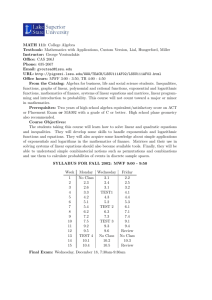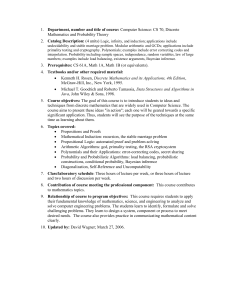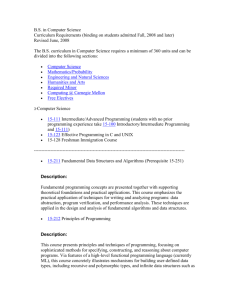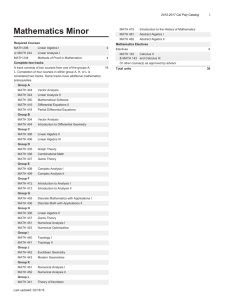Title (Units): - Department of Mathematics, Hong Kong Baptist
advertisement
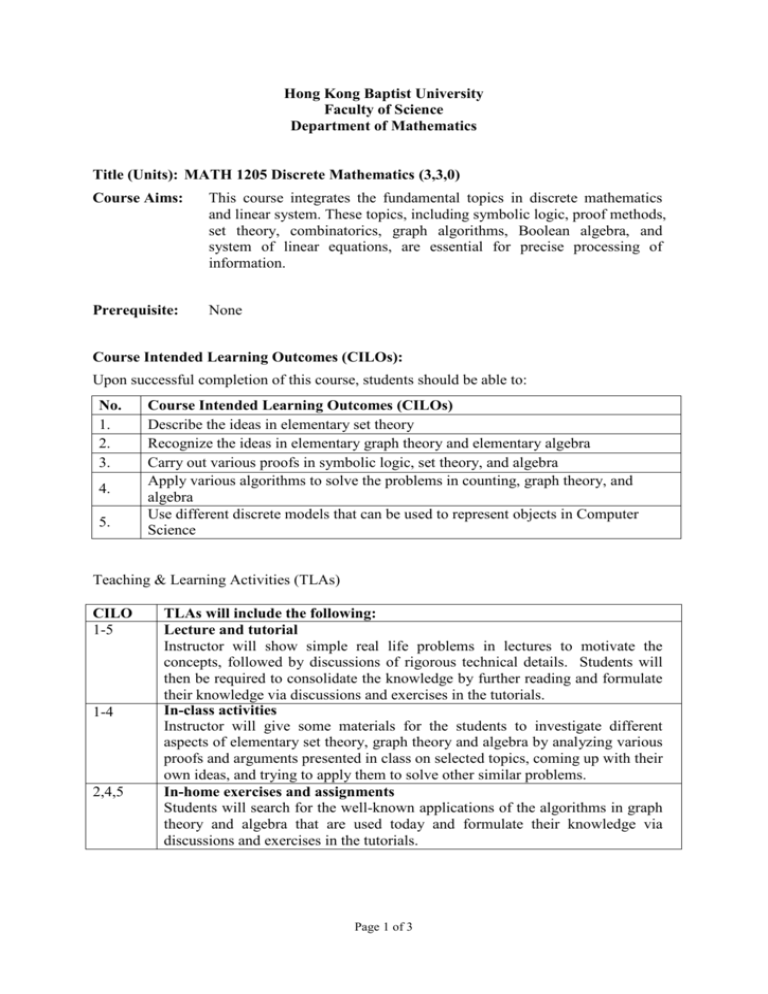
Hong Kong Baptist University Faculty of Science Department of Mathematics Title (Units): MATH 1205 Discrete Mathematics (3,3,0) Course Aims: This course integrates the fundamental topics in discrete mathematics and linear system. These topics, including symbolic logic, proof methods, set theory, combinatorics, graph algorithms, Boolean algebra, and system of linear equations, are essential for precise processing of information. Prerequisite: None Course Intended Learning Outcomes (CILOs): Upon successful completion of this course, students should be able to: No. 1. 2. 3. 4. 5. Course Intended Learning Outcomes (CILOs) Describe the ideas in elementary set theory Recognize the ideas in elementary graph theory and elementary algebra Carry out various proofs in symbolic logic, set theory, and algebra Apply various algorithms to solve the problems in counting, graph theory, and algebra Use different discrete models that can be used to represent objects in Computer Science Teaching & Learning Activities (TLAs) CILO 1-5 1-4 2,4,5 TLAs will include the following: Lecture and tutorial Instructor will show simple real life problems in lectures to motivate the concepts, followed by discussions of rigorous technical details. Students will then be required to consolidate the knowledge by further reading and formulate their knowledge via discussions and exercises in the tutorials. In-class activities Instructor will give some materials for the students to investigate different aspects of elementary set theory, graph theory and algebra by analyzing various proofs and arguments presented in class on selected topics, coming up with their own ideas, and trying to apply them to solve other similar problems. In-home exercises and assignments Students will search for the well-known applications of the algorithms in graph theory and algebra that are used today and formulate their knowledge via discussions and exercises in the tutorials. Page 1 of 3 Assessment: No. Assessment Methods Weighting 1 Continuous Assessment 30% 2 Final 70% Examination CILO Remarks Addressed 1,2,3,4,5 Continuous Assessment are designed to measure how well the students have learned the logics, set theory, combinatorics, graph algorithms, Boolean algebra, and system of linear equations. These continuous assessments include, but not limited to, in class discussions and problem solving exercises. 1,2,3,4 Final Examination questions are designed to see how far students have achieved their intended learning outcomes. Questions will primarily be analysis and skills based to assess the student's ability in analysis the problems, formulating the models and applying the appropriate algorithms to find the answers. Course Intended Learning Outcomes and Weighting: CILO No. 1,3 2,4,5 1,3 2,4 2,4,5 2,4,5 Contents I II III IV V VI Symbolic Logic and Proofs Boolean Algebra Set Theory Combinatorics System of Linear Equations Graph Algorithms Teaching (in hours) 8 5 8 6 5 7 Textbook: S. Epp, Discrete Mathematics with Applications, 3rd Ed., Brooks Cole, 2003. References: K.H. Rosen, Discrete Mathematics and Its Applications, 6th Ed., McGrawHill, 2006. R. Johnsonbaugh, Discrete Mathematics, 7th Ed., Prentice Hall, 2008. R.A. Ross and C.R.B. Wright, Discrete Mathematics, 5th Ed., Prentice Hall, 2002. Page 2 of 3 Course Contents in Outline: Topics Hours I. Symbolic Logic and Proofs A. Propositions B. Conditional Propositional and Logical Equivalence C. “There exists” and “for all” quantifiers D. Methods of Proof E. Mathematical Induction 8 II. Boolean Algebra A. Boolean Functions B. Representing Boolean Functions C. Logic Gates D. Minimization of Circuits 5 III. Set Theory A. Sets B. Sequences and Strings C. Relations D. Functions 8 IV. Combinatorics A. Permutations B. Combinations C. The Pigeonhole Principle D. Recurrence Relations 6 V. System of Linear Equations A. Matrix Arithmetic B. Solutions of Systems of Linear Equations C. Inverses of Matrices D. Determinants 5 VI. Graph Algorithms A. Terminology of Graphs B. Path and Cycles C. Hamiltonian Cycles and the Traveling Salesperson Problem D. Shortest Path Problem E. Spanning Trees and Minimal Spanning Trees 7 . Page 3 of 3

